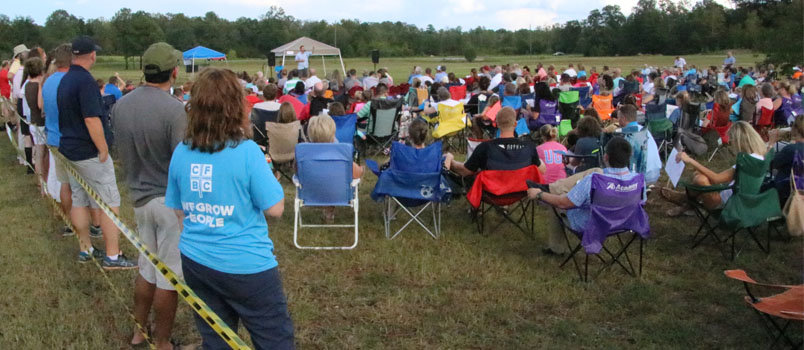 Members of Cartersville First Baptist Church gathered Aug. 21 in the space designated for a 1,200-seat worship center. It will be built as part of The Legacy Project, a program to meet current growth and prepare for ministry in the future. SCOTT BARKLEY/Special
Members of Cartersville First Baptist Church gathered Aug. 21 in the space designated for a 1,200-seat worship center. It will be built as part of The Legacy Project, a program to meet current growth and prepare for ministry in the future. SCOTT BARKLEY/SpecialCARTERSVILLE — Citing an explosion in growth and responsibility to prepare for ministry in the future, a collection of Cartersville First Baptist Church leaders presented Vision Sunday on Aug. 21 in morning services as well as an evening outdoor service in the footprint of its potential worship center.
“Faith becomes a legacy when you pass it on to someone else,” CFBC Pastor Jeremy Morton said to those gathered at both Vision Sunday morning services. He then pointed to events, both good and bad, common to most churches. As a result, he emphasized, all churches arrive at a point of action.
“Cartersville First Baptist has been here a long time,” he said. “Civil War, Industrial Revolution, two World Wars, Great Depression, racial injustice of the Jim Crow era – it’s been through a lot. Yet, here we are by the grace of God.”
Here encompasses Bartow County in addition to neighboring Cobb, Paulding, and Polk counties, all within 10 miles of the CFBC campus. Attractions such as Lakepoint Sporting Community make the area one of the most enticing for growth in the state. In fact, expectations for Bartow County in the next 4-5 years alone include 5,000 new residents.
In a video shown to attendees, Morton cited one prediction by the Georgia Chamber of Commerce’s findings that by 2030 Bartow County’s population could reach 200,000.
First Baptist is going through a youth movement, Morton said Sunday morning, with 40 percent of weekly attenders being 18 years old and under. As such, one aspect of church life can’t be ignored.
“Since 2014 our attendance is up 53 percent,” he noted. In that time, he added, 139 baptisms have taken place as well. Those numbers place a responsibility on CFBC to be “a disciple-making factory,” he exclaimed.
The extended plan contains three phases. Phase I, to be voted on this Sunday, pertains to an extension of the preschool wing. Phase II addresses the current reality of 1,100 people filling two services in a worship center built to hold 500 comfortably. Phase III addresses student ministry needs. Phase IV focuses on administration space, rooms for small groups, and renovating future space as needed.
Morton expects Phase I, if accepted, to begin sometime this fall with a completion date next summer. CFBC already has a good portion of the capital for that phase, Morton said. Subsequent construction scheduling will be contingent on fundraising needs at that time.
The building program, dubbed The Legacy Project, won’t draw away from the church’s current efforts toward evangelism. In fact, Morton’s expectations are to add to the 49 people who took part in international missions this summer. On top of that, giving to missions is going to be intrinsically linked with giving to the building program in order to spur both.
Morton addressed one challenge with which pastors introducing building programs are familiar. Though using different terminology, he then pointed to the importance of evangelism, discipleship, and missions.
“The building is not the goal,” he stressed. “People is what we’re about, not buildings. … We bring people in, coach people up, and send people out.
“Our interest isn’t bigger buildings, it’s bigger Christians.”
Morton cited the increasing number of church members either having already adopted children or are pursuing it. In addition, ministry leaders note more requests by parents of children with special needs. Sponsorships of children through organizations such as Compassion International – the church supports nearly 300 children – continue to grow as well.
“We want to help the growing population of unchurched parents of children with special needs,” Morton emphasized.
Last Sunday evening, a crowd walked through First Baptist’s building to its back property. They carried lawn chairs and questions to a section marking off a future 1,200-seat worship center. Soon thereafter, they took part in a brief worship time with music minister Derrick Jackson and some words by Morton.
While the lawn chairs remained, attendees took their questions to tents marking off different phases of construction. Also, they looked at diagrams of each phase and artist renderings of future ministry possibilities.
A pastor can expect pushback from a building program. To that point, the total estimation of The Legacy Project – Phases I-IV – comes to $15.7 million.
Still, Morton wouldn’t describe those hesitant as critics. Far from it.
“A couple of people I respect have concerns – and rightfully so – of the financial commitment,” he expressed. “But, no one has been confrontational or negative in their remarks. They just want a clear plan for how we’re going to reach these goals.
“I think God is going to honor our people’s generosity. I’m also thankful for the church leadership and finance team to use Christian stewardship. Without them this wouldn’t be possible.”